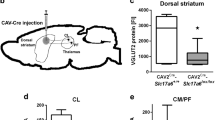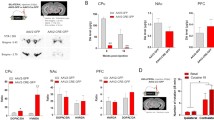Abstract
Clostridial light chain (LC) inhibits synaptic transmission by digesting a vesicle-docking protein, synaptobrevin, without killing neurons. We here report the feasibility of creating a rat hemiparkinsonism model through LC gene expression in the substantia nigra (SN), inhibiting nigrostriatal transmission. 40 adult Sprague Dawley rats were divided into four groups for SN injections of PBS, 6-hydroxydopamine (6-OHDA), or adenoviral vectors for the expression of LC (AdLC), or GFP (AdGFP). Amphetamine and apomorphine induced rotations were assessed before and after SN injection, revealing significant rotational alterations at 8 or 10 days after injection in both AdLC and 6-OHDA but not PBS and AdGFP groups. Induced rotation recovered by one month in AdLC rats but persisted in 6-OHDA rats. Histological analysis of the SN revealed LC and GFP expression with corresponding synaptobrevin depletion in the LC, but not the GFP groups. Tyrosine hydroxylase (TH) and dopamine transporter (DAT) immunohistochemistry (IHC) showed markedly decreased staining in ipsilateral SN and striatum in 6-OHDA but not AdLC or AdGFP rats. Similarly, compared with contralateral, ipsilateral striatal dopamine level only decreased in 6-OHDA but not AdLC, AdGFP, or PBS treated rats. Thus, LC expression induces nigral synaptobrevin depletion with resulting inhibition of nigrostriatal synaptic transmission. Unlike 6-OHDA, LC expression inhibits synaptic activity without killing neurons. This approach, therefore, represents a potentially reversible means of nigrostriatal pathway inhibition as a model for Parkinson’s disease. Such a model might facilitate transient and controlled nigral inhibition for studying striatal recovery, dopaminergic re-innervation, and normalization of striatal receptors following the recovery of nigrostriatal transmission.





Similar content being viewed by others
References
Baron, U., & Bujard, H. (2000). Tet repressor-based system for regulated gene expression in eukaryotic cells: principles and advances. Methods in Enzymology, 327, 401–421.
Beal, M. F. (2001). Experimental models of Parkinson’s disease. Nature Reviews. Neuroscience, 2, 325–334.
Blomer, U., Naldini, L., Kafri, T., Trono, D., Verma, I. M., & Gage, F. H. (1997). Highly efficient and sustained gene transfer in adult neurons with a lentivirus vector. Journal of Virology, 71, 6641–6649.
Bove, J., Prou, D., Perier, C., & Przedborski, S. (2005). Toxin-induced models of Parkinson’s disease. NeuroRx, 2, 484–494.
Cha, G. H., Kim, S., Park, J., Lee, E., Kim, M., Lee, S. B., Kim, J. M., Chung, J., & Cho, K. S. (2005). Parkin negatively regulates JNK pathway in the dopaminergic neurons of Drosophila. Proceedings of the National Academy of Sciences of the United States of America, 102, 10345–10350.
Creese, I., Burt, D. R., & Snyder, S. H. (1977). Dopamine receptor binding enhancement accompanies lesion-induced behavioral supersensitivity. Science, 197, 596–598.
Davis, A., Stachler, M., Shi, W., Liu, J., Boulis, N., & Bartlett, J. (2005). Manipulating AAV2 tropism for enhanced delivery of AAV vectors to the spinal cord. Molecular Therapy, 11, S46.
Deumens, R., Blokland, A., & Prickaerts, J. (2002). Modeling Parkinson’s disease in rats: an evaluation of 6-OHDA lesions of the nigrostriatal pathway. Experimental Neurology, 175, 303–317.
Federici, T., Teng, Q., Garrity-Moses, M., Krudy, C., Yang, J., & Boulis, N. M. (2006). Adenovirus-Light Chain Inhibition of Growth Hormone Release from Pituitary Adenoma Cells. Molecular Therapy,13 Supplement 1, S54.
Freed C., Greene P., Breeze R., Tsai W., DuMouchel W., Kao R., Dillon S., Winfield H., Culver S., Trojanowski J., Eidelberg D., & Fahn S. (2001). Transplantation of Embryonic Dopamine Neurons for Severe Parkinson’s Disease. The New England Journal of Medicine, 344, 710–719.
Ghorayeb, I., Puschban, Z., Fernagut, P. O., Scherfler, C., Rouland, R., Wenning, G. K., & Tison, F. (2001). Simultaneous intrastriatal 6-hydroxydopamine and quinolinic acid injection: a model of early-stage striatonigral degeneration. Experimental Neurology, 167, 133–147.
Hardy, S., Kitamura, M., Harris-Stansil, T., Dai, Y., & Phipps, M. L. (1997). Construction of adenovirus vectors through Cre-lox recombination. Journal of Virology, 71, 1842–1849.
Humeau, Y., Doussau, F., Grant, N. J., & Poulain, B. (2000). How botulinum and tetanus neurotoxins block neurotransmitter release. Biochimie, 82, 427–446.
Iancu, R., Mohapel, P., Brundin, P., & Paul, G. (2005). Behavioral characterization of a unilateral 6-OHDA-lesion model of Parkinson’s disease in mice. Behavioural Brain Research, 162, 1–10.
Kirik, D., Rosenblad, C., & Bjorklund, A. (1998). Characterization of behavioral and neurodegenerative changes following partial lesions of the nigrostriatal dopamine system induced by intrastriatal 6-hydroxydopamine in the rat. Experimental Neurology, 152, 259–277.
Lin, R. C., & Scheller, R. H. (2000). Mechanisms of synaptic vesicle exocytosis. Annual Review of Cell and Developmental Biology, 16, 19–49.
Meloni, E., & Davis, M. (2000). Enhancement of acoustic startle response by dopamine agonists after 6-hydroxydopamine lesions of the substantia nigra pars compacta: corresponding changes in c-Fos expression in the caudate-putamen. Brain Research, 879, 93–104.
Meshul, C., Emre, N., Nakamura, C., Allen, C., Donohue, M., & Buckman, J. (1999). Time-dependent changes in striatal glutamate synapses following a 6-hydroxydopamine lesion. Neuorscience, 88, 1–16.
Miller, G. W., Gainetdinov, R. R., Levey, A. I., & Caron, M. G. (1999). Dopamine transporters and neuronal injury. Trends in Pharmacological Sciences, 20, 424–429.
Montecucco, C., & Schiavo, G. (1993). Tetanus and botulism neurotoxins: a new group of zinc proteases. Trends in Biochemical Sciences, 18, 324–327.
Muma, N., Lee, J., Gorman, L., Heidenreich, B., Mitrovic, I., & Napier, T. (2001). 6-hydroxydopamine-induced lesions of dopaminergic neurons alter the function of postsynaptic cholinergic neurons without changing cytoskeletal proteins. Experimental Neurology, 168, 135–143.
Olanow, C., Goetz, C., Kordower, J., Stoessl, A., Sossi, V., Brin, M., Shannon, K., Nauert, G., Perl, D., Godbold, J., & Freeman, T. (2003). A double-blind controlled trial of bilateral fetal nigral transplantation in Parkinson’s disease. Annals of Neurology, 54, 403–414.
Paxinos, G. (1982). The rat brain in stereotaxic coordinates. San Diego: Academic Press.
Peel, A. L., & Klein, R. L. (2000). Adeno-associated virus vectors: activity and applications in the CNS. Journal of Neuroscience Methods, 98, 95–104.
Potter, D. W., DiPietro, M. A., Seitzer, J. L., Katakam, A., & Kumar, P. (2006). Adenoviral Delivery of the RheoSwitch Therapeutic System to Mouse Brain and Liver. Molecular Therapy, 327, 401–421.
Rossetto, O., Seveso, M., Caccin, P., Schiavo, G., & Montecucco, C. (2001). Tetanus and botulinum neurotoxins: turning bad guys into good by research. Toxicon, 39, 27–41.
Rowell, C., Carpenter, D. M., & Lamartiniere, C. A. (2005). Chemoprevention of breast cancer, proteomic discovery of genistein action in the rat mammary gland. The Journal of Nutrition, 135, 2953S–2959S.
Schiavo, G., Rossetto, O., & Montecucco, C. (1994). Clostridial neurotoxins as tools to investigate the molecular events of neurotransmitter release. Seminars in Cell Biology, 5, 221–229.
Shimohama, S., Sawada, H., Kitamura, Y., & Taniguchi, T. (2003). Disease model: Parkinson’s disease. Trends in Molecular Medicine, 9, 360–365.
Sindhu, K. M., Saravanan, K. S., & Mohanakumar, K. P. (2005). Behavioral differences in a rotenone-induced hemiparkinsonian rat model developed following intranigral or median forebrain bundle infusion. Brain Research, 1051, 25–34.
St-Hilaire, M., Landry, E., Levesque, D., & Rouillard, C. (2005). Denervation and repeated L-DOPA induce complex regulatory changes in neurochemical phenotypes of striatal neurons: implication of a dopamine D1-dependent mechanism. Neurobiology of Disease, 20, 450–460.
Sudhof, T. C. (1995). The synaptic vesicle cycle: a cascade of protein-protein interactions. Nature, 375, 645–653.
Teng, Q., Tanase, D. K., Liu, J. K., Garrity-Moses, M. E., Baker, K. B., & Boulis, N. M. (2005). Adenoviral clostridial light chain gene-based synaptic inhibition through neuronal synaptobrevin elimination. Gene Therapy, 12, 108–119.
Waldner, R., Puschban, Z., Scherfler, C., Seppi, K., Jellinger, K., Poewe, W., & Wenning, G. K. (2001). No functional effects of embryonic neuronal grafts on motor deficits in a 3-nitropropionic acid rat model of advanced striatonigral degeneration (multiple system atrophy). Neuroscience, 102, 581–592.
Yamamoto, M., Wada, N., Kitabatake, Y., Watanabe, D., Anzai, M., Yokoyama, M., Teranishi, Y., & Nakanishi, S. (2003). Reversible suppression of glutamatergic neurotransmission of cerebellar granule cells in vivo by genetically manipulated expression of tetanus neurotoxin light chain. The Journal of Neuroscience, 23, 6759–6767.
Yang, J., Teng, Q., Federici, T., Najm, I., Chabardes, S., Moffitt, M., Alexopoulos, A., Riley, J., & Boulis, N. M. (2007). Viral Clostridial Light Chain Gene-based Control of Penicillin-induced Neocortical Seizures. Molecular Therapy, 15, 542–551.
Yurek, D. M., & Fletcher-Turner, A. (2004). Comparison of embryonic stem cell-derived dopamine neuron grafts and fetal ventral mesencephalic tissue grafts: morphology and function. Cell Transplantion, 13, 295–306.
Zhao, Z., Krishnaney, A., Teng, Q., Yang, J., Garrity-Moses, M., Liu, J. K., Venkiteswaran, K., Subramanian, T., Davis, M., & Boulis, N. M. (2006). Anatomically discrete functional effects of adenoviral clostridial light chain gene-based synaptic inhibition in the midbrain. Gene Therapy, 13, 942–952.
Zhuang, X., Masson, J., Gingrich, J., Rayport, S., & Hen, R. (2005). Targeted gene expression in dopamine and serotonin neurons of the mouse brain. Journal of Neuroscience Methods, 143, 27–32.
Acknowledgment
This research was supported by the grant from NINDS KO8 NS43305.
Author information
Authors and Affiliations
Corresponding author
Rights and permissions
About this article
Cite this article
Yang, J., Teng, Q., Garrity-Moses, M.E. et al. Reversible Unilateral Nigrostriatal Pathway Inhibition Induced Through Expression of Adenovirus-mediated Clostridial Light Chain Gene in the Substantia Nigra. Neuromol Med 9, 276–284 (2007). https://doi.org/10.1007/s12017-007-8003-0
Received:
Accepted:
Published:
Issue Date:
DOI: https://doi.org/10.1007/s12017-007-8003-0




